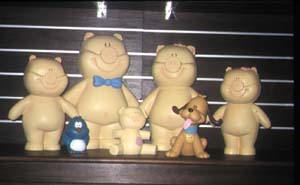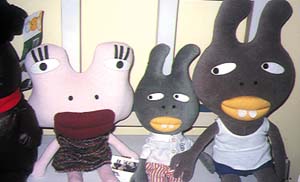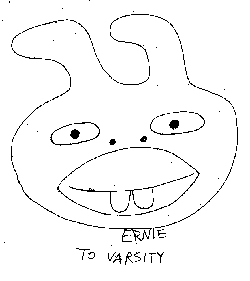



Local cartoon characters
Getting recognized by being different
By Mandy Fu
Cartoon characters permeate daily life in Hong Kong. Although most of them are imports, locally designed cartoons are entering the market to compete with those from overseas.
Mr. Ernie Au is the creator of Ah Fu, a character from the storybook Over the Rainbow. He wants Ah Fu to be ugly in order to stand out.
Said Mr. Au: “There are so many cute cartoon characters in the market. To be special, I want Ah Fu to be ugly.
“Originally Ah Fu was yellow, but I changed it to greenish grey. I wanted Ah Fu to look more untidy.”
Looks are not the only things that distinguish local cartoons from foreign ones. Background stories are also a major difference.
“Stories do help a lot. The story behind Ah Fu presents both the personalities of Ah Fu and a local environment, Choi Hung Estate.”
Mr. Au said the local settomg enables Ah Fu to be part of local culture rather than just a trend, allowing it to survive in the market over time.
Evercare Limited is a local company producing gifts and cards.
Mr. Denys Tse Kam Wing, managing director, said large companies have moved the focus of creation and production of cartoon characters to overseas markets.
“The market of Hong Kong is comparatively small owing to its small land area and population. Production costs are therefore quite high,” he said.
“Running a business in Hong Kong for a cartoon character requires huge financial support and powerful promotions.”
Pork Chop and Friends, under the Close to Heart Collection of Daynice International Limited, are also locally designed cartoon characters.
Mr. Vincent Lai, business development manager of Daynice, said running a cartoon business should be regarded as a long term investment.
He said that Pork Chop and Friends was started as an exhibition by the Trade Development Council in 1996. Popularity was not instantaneous, however.
“Some corporations said they would not use designs from Hong Kong,” said Mr. Lai.
As local designers compete with foreign cartoons, they struggle to be more creative.
He said local designers are limited to Japanese styles, with a high degree of imitation.
“The prejudices eased as we improved and innovated our products. We finally got recognition from overseas companies.”
He said the Daynice noticed that Hong Kong lacked original cartoons, so it began to concentrate on the production of Pork Chop and Friends in 2000. Now its products are available at Kalm’s, a Hong Kong-based chain of novelty shops.
Ms. Lo Yen Sher is the regional merchandising manager of Kalm’s.Said she: “Sales for the products of Pork Chop and Friends are doing quite well for us. We choose to sell it because it is cute and has mass appeal.
“But Hello Kitty is still the top sales character in Hong Kong due to its wide range of (related) items.”
Ms. Lo said that even though Japanese characters are popular in Hong Kong, they usually have a short shelf-life.
Mr. Au, the designer of Ah Fu, said personal interest is the main driving force for local designers.
“This is neither a profession nor an academic subject. They will draw and contribute their work if they are interested and want to be recognised.”